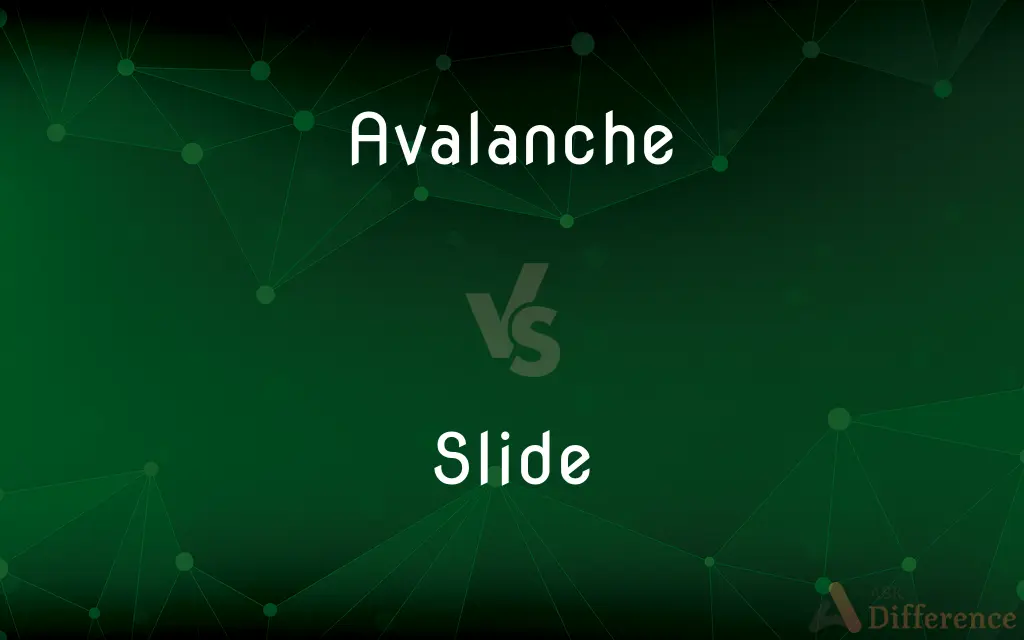Avalanche vs. Slide — What's the Difference?
Edited by Tayyaba Rehman — By Maham Liaqat — Updated on March 30, 2024
An avalanche is a rapid flow of snow down a sloping surface, often triggered by factors like snowpack, terrain, and weather, whereas a slide refers to any movement of material, such as rock, earth, or snow, down a slope.

Difference Between Avalanche and Slide
Table of Contents
ADVERTISEMENT
Key Differences
Avalanches specifically involve snow and ice, occurring in mountainous regions and can be triggered by natural processes or human activities. They are categorized into different types based on their cause and the materials involved, like loose snow avalanches or slab avalanches. Slides encompass a broader range of material movement, including landslides, mudslides, and rockslides, in addition to snow slides, which are essentially snow avalanches.
The dynamics of an avalanche are heavily influenced by the snowpack's structure, the slope's gradient, and external conditions such as temperature and precipitation. Slides, on the other hand, can be influenced by a variety of factors depending on the material, including soil saturation, geological instability, or even vegetation cover, highlighting the diverse causes and natures of slides compared to avalanches.
Safety and risk management practices for avalanches focus on understanding snow conditions, terrain analysis, and often include the use of equipment like avalanche transceivers and airbags. In contrast, slide risk management might involve geological assessments, land use planning, and engineering solutions to stabilize slopes or divert flow paths, demonstrating the different approaches required to mitigate these hazards.
Conservation and emergency response efforts for avalanches often involve avalanche forecasting, public education on safety practices, and rescue team preparedness. Slide management, particularly for landslides and mudslides, may include early warning systems, evacuation planning, and post-event recovery efforts, underlining the tailored strategies needed to address the specific challenges posed by different types of slides.
Comparison Chart
Definition
Rapid flow of snow down a slope
Movement of material (rock, earth, snow) down a slope
ADVERTISEMENT
Types
Loose snow avalanche, slab avalanche
Landslide, mudslide, rockslide, snow slide
Influencing Factors
Snowpack structure, slope gradient, temperature
Soil saturation, geological stability, vegetation
Safety Practices
Terrain analysis, avalanche transceivers
Geological assessments, land use planning
Risk Management
Understanding snow conditions
Stabilizing slopes, engineering solutions
Compare with Definitions
Avalanche
Safety equipment.
Skiers wear avalanche transceivers for safety in prone areas.
Slide
General term for material movement.
The heavy rain caused a mudslide blocking the road.
Avalanche
Triggered by various factors.
A loud noise can sometimes trigger a snow avalanche.
Slide
Can include various materials.
Rockslides can pose significant dangers in mountain passes.
Avalanche
Types based on snowpack.
Slab avalanches occur when a cohesive layer of snow slides off.
Slide
Influenced by many factors.
Deforestation has increased the risk of landslides.
Avalanche
Rapid snow movement.
The avalanche buried the ski trail under meters of snow.
Slide
Broader than avalanches.
Slides encompass earth, rock, and snow movements.
Avalanche
Mountainous regions.
Avalanches are common in the Rocky Mountains during spring.
Slide
Engineering solutions.
Retaining walls are built to prevent potential slides in vulnerable areas.
Avalanche
An avalanche (also called a snowslide) is a rapid flow of snow down a slope, such as a hill or mountain.Avalanches can be set off spontaneously, by such factors as increased precipitation or snowpack weakening, or by external means such as humans, animals, and earthquakes. Primarily composed of flowing snow and air, large avalanches have the capability to capture and move ice, rocks, and trees.
Slide
To move over a surface while maintaining smooth continuous contact.
Avalanche
A fall or slide of a large mass of material, especially of snow, down a mountainside.
Slide
To participate in a sport that involves such movement
Sliding for a medal in luge.
Avalanche
A massive or overwhelming amount; a flood
Received an avalanche of mail.
Slide
To lose a secure footing or positioning; slip
Slid on the ice and fell.
Avalanche
To fall or slide in a massive or overwhelming amount.
Slide
To pass smoothly and quietly; glide
Slid past the door without anyone noticing.
Avalanche
To overwhelm; inundate.
Slide
(Baseball) To drop down from a running into a lying or diving position when approaching a base so as to avoid being tagged out.
Avalanche
A large mass or body of snow and ice sliding swiftly down a mountain side, or falling down a precipice.
Slide
To be ignored or not dealt with; drop
Let the matter slide.
Avalanche
A fall of earth, rocks, etc., similar to that of an avalanche of snow or ice.
Slide
To decrease
Prices slid in morning trading.
Avalanche
(by extension) A sudden, great, or irresistible descent or influx; anything like an avalanche in suddenness and overwhelming quantity.
Slide
To become less favorable or less desirable
Economic conditions have begun to slide.
Avalanche
(intransitive) To descend like an avalanche.
Slide
To cause to slide or slip
Slid the glass down to the other end of the counter.
Avalanche
(transitive) To come down upon; to overwhelm.
The shelf broke and the boxes avalanched the workers.
Slide
To place covertly or deftly
Slid the stolen merchandise into his pocket.
Avalanche
(transitive) To propel downward like an avalanche.
Slide
A sliding movement or action.
Avalanche
A large mass or body of snow and ice sliding swiftly down a mountain side, or falling down a precipice.
Slide
A smooth, usually inclined surface or track for sliding
A water slide.
Avalanche
A fall of earth, rocks, etc., similar to that of an avalanche of snow or ice.
Slide
A playground apparatus for children to slide on, typically consisting of a smooth chute climbed onto by means of a ladder.
Avalanche
A sudden, great, or irresistible descent or influx of anything.
Slide
A part that operates by sliding, as the U-shaped section of tube on a trombone that is moved to change the pitch.
Avalanche
A slide of large masses of snow and ice and mud down a mountain
Slide
A period of decline or loss
"The semiconductor industry is heading for a cyclical slide" (New York Times).
Avalanche
A sudden appearance of an overwhelming number of things;
The program brought an avalanche of mail
Slide
An image on a transparent base for projection on a screen.
Avalanche
Of snow masses in the mountains
Slide
One of a series of images projected digitally as part of a presentation.
Slide
A small glass plate for mounting specimens to be examined under a microscope.
Slide
A fall of a mass of rock, earth, or snow down a slope; an avalanche or landslide.
Slide
A backless shoe with an open toe.
Slide
A slight portamento used in violin playing, passing quickly from one note to another.
Slide
An ornamentation consisting of two grace notes approaching the main note.
Slide
A small metal or glass tube worn over a finger or held in the hand, used in playing bottleneck-style guitar.
Slide
The bottleneck style of guitar playing.
Slide
(ergative) To (cause to) move in continuous contact with a surface.
He slid the boat across the grass.
The safe slid slowly.
Snow slides down the side of a mountain.
Slide
(intransitive) To move on a low-friction surface.
The car slid on the ice.
Slide
To drop down and skid into a base.
Jones slid into second.
Slide
(intransitive) To lose one’s balance on a slippery surface.
He slid while going around the corner.
Slide
(transitive) To pass or put imperceptibly; to slip.
To alter the meaning of a question by sliding in a word
Schoolchildren sometimes slide each other notes during class.
Slide
(transitive) To subtly direct a facial expression at (someone).
He slid me a dirty look.
Slide
To pass inadvertently.
Slide
(intransitive) To pass along smoothly or unobservedly; to move gently onward without friction or hindrance.
A ship or boat slides through the water.
Slide
To decrease in amount or value.
The stock market slid yesterday after major stocks released weak quarterly results.
Slide
(music) To smoothly pass from one note to another by bending the pitch upwards or downwards.
Slide
(regional) To ride down snowy hills upon a toboggan or similar object for recreation.
Slide
To go; to move from one place or to another.
Slide
(soccer) To kick so that the ball slides along the ground with little or no turning.
Slide
An item of play equipment that children can climb up and then slide down again.
The long, red slide was great fun for the kids.
Slide
A surface of ice, snow, butter, etc. on which someone can slide for amusement or as a practical joke.
Slide
The falling of large amounts of rubble, earth and stones down the slope of a hill or mountain; avalanche.
The slide closed the highway.
Slide
An inclined plane on which heavy bodies slide by the force of gravity, especially one constructed on a mountainside for conveying logs by sliding them down.
Slide
A mechanism consisting of a part which slides on or against a guide.
Slide
The act of sliding; smooth, even passage or progress.
A slide on the ice
Slide
A lever that can be moved in two directions.
Slide
A valve that works by sliding, such as in a trombone.
Slide
(photography) A transparent plate bearing an image to be projected to a screen.
Slide
A page of a computer presentation package such as PowerPoint.
I still need to prepare some slides for my presentation tomorrow.
Slide
(sciences) A flat, usually rectangular piece of glass or similar material on which a prepared sample may be viewed through a microscope Generally referred to as a microscope slide.
Slide
(baseball) The act of dropping down and skidding into a base
Slide
A hand-held device made of smooth, hard material, used in the practice of slide guitar.
Slide
A lively dance from County Kerry, in 12/8 time.
Slide
(geology) A small dislocation in beds of rock along a line of fissure.
Slide
(music) A grace consisting of two or more small notes moving by conjoint degrees, and leading to a principal note either above or below.
Slide
(phonetics) A sound which, by a gradual change in the position of the vocal organs, passes imperceptibly into another sound.
Slide
A clasp or brooch for a belt, etc.
Slide
A pocket in one's pants (trousers).
With ten dollars in his slide
Slide
(footwear) A shoe that is backless and open-toed.
Slide
(speech therapy) A voluntary stutter used as a technique to control stuttering in one's speech.
Slide
A promiscuous woman, slut.
Slide
To move along the surface of any body by slipping, or without walking or rolling; to slip; to glide; as, snow slides down the mountain's side.
Slide
Especially, to move over snow or ice with a smooth, uninterrupted motion, as on a sled moving by the force of gravity, or on the feet.
They bathe in summer, and in winter slide.
Slide
To pass inadvertently.
Beware thou slide not by it.
Slide
To pass along smoothly or unobservedly; to move gently onward without friction or hindrance; as, a ship or boat slides through the water.
Ages shall slide away without perceiving.
Parts answering parts shall slide into a whole.
Slide
To slip when walking or standing; to fall.
Their foot shall slide in due time.
Slide
To pass from one note to another with no perceptible cassation of sound.
Slide
To pass out of one's thought as not being of any consequence.
With good hope let he sorrow slide.
With a calm carelessness letting everything slide.
Slide
To cause to slide; to thrust along; as, to slide one piece of timber along another.
Slide
To pass or put imperceptibly; to slip; as, to slide in a word to vary the sense of a question.
Slide
The act of sliding; as, a slide on the ice.
Slide
Smooth, even passage or progress.
A better slide into their business.
Slide
That on which anything moves by sliding.
Slide
That which operates by sliding.
Slide
A plate or slip of glass on which is a picture or delineation to be exhibited by means of a magic lantern, stereopticon, or the like; a plate on which is an object to be examined with a microscope.
Slide
The descent of a mass of earth, rock, or snow down a hill or mountain side; as, a land slide, or a snow slide; also, the track of bare rock left by a land slide.
Slide
A small dislocation in beds of rock along a line of fissure.
Slide
A grace consisting of two or more small notes moving by conjoint degrees, and leading to a principal note either above or below.
Slide
A sound which, by a gradual change in the position of the vocal organs, passes imperceptibly into another sound.
Slide
Same as Guide bar, under Guide.
Slide
A small flat rectangular piece of glass on which specimens can be mounted for microscopic study
Slide
(geology) the descent of a large mass of earth or rocks or snow etc.
Slide
(music) rapid sliding up or down the musical scale;
The violinist was indulgent with his swoops and slides
Slide
Plaything consisting of a sloping chute down which children can slide
Slide
The act of moving smoothly along a surface while remaining in contact with it;
His slide didn't stop until the bottom of the hill
The children lined up for a coast down the snowy slope
Slide
A transparency mounted in a frame; viewed with a slide projector
Slide
Sloping channel through which things can descend
Slide
Move obliquely or sideways, usually in an uncontrolled manner;
The wheels skidded against the sidewalk
Slide
To pass or move unobtrusively or smoothly;
They slid through the wicket in the big gate
Slide
Move smoothly along a surface;
He slid the money over to the other gambler
Common Curiosities
What preventive measures can be taken for avalanches?
Preventive measures include avalanche forecasting, educating people on snow safety, and using protective gear.
How are slides managed or mitigated?
Slides can be managed through geological assessments, engineering interventions like retaining walls, and proper land use planning to reduce risk.
What primarily causes an avalanche?
Avalanches are primarily caused by the destabilization of a snowpack on a sloped surface, which can happen naturally or from human disturbance.
How does a slide differ from an avalanche in terms of material?
A slide refers to the movement of various materials, including rock, earth, or snow, while an avalanche specifically involves snow and ice.
What role does climate play in avalanches and slides?
Climate affects the frequency and intensity of both avalanches and slides, with factors like precipitation, temperature, and weather patterns being significant.
Are avalanches more dangerous than other types of slides?
The danger level of an avalanche compared to other slides depends on various factors like scale, location, and human exposure. Each can be extremely dangerous under certain conditions.
Can human activities trigger slides?
Yes, activities such as construction, deforestation, and mining can destabilize land and trigger slides.
How do communities prepare for avalanche risks?
Communities in avalanche-prone areas prepare through education, evacuation planning, and by installing protective structures like avalanche barriers.
What is the impact of avalanches and slides on the environment?
Both can dramatically alter landscapes, affect ecosystems, and disrupt human activities and infrastructure.
How can technology help predict avalanches and slides?
Technology, including satellite imagery, remote sensors, and predictive modeling, helps in the early detection and forecasting of potential avalanches and slides.
Share Your Discovery

Previous Comparison
Hustle vs. Hassle
Next Comparison
Rizatriptan vs. SumatriptanAuthor Spotlight
Written by
Maham LiaqatEdited by
Tayyaba RehmanTayyaba Rehman is a distinguished writer, currently serving as a primary contributor to askdifference.com. As a researcher in semantics and etymology, Tayyaba's passion for the complexity of languages and their distinctions has found a perfect home on the platform. Tayyaba delves into the intricacies of language, distinguishing between commonly confused words and phrases, thereby providing clarity for readers worldwide.
















































